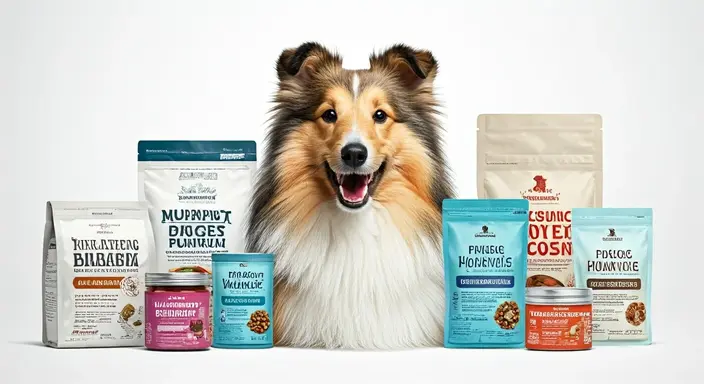Picture this: your Shetland Sheepdog, with its lush double coat and bright eyes, suddenly starts scratching relentlessly. Maybe they’re refusing meals or dealing with recurring ear infections. While these signs might seem unrelated, they could point to a hidden culprit—food allergies or sensitivities.
Shetland Sheepdogs, or Shelties, are known for their intelligence and agility, but their sensitive digestive systems and genetic predispositions make them prone to adverse reactions to certain foods. Unlike generic advice for dogs, Shelties often face unique triggers tied to their breed’s biology. For example, their thick coats can mask skin irritations, while their high energy levels might make subtle lethargy easy to overlook.
Why This Matters
Left unmanaged, food-related issues can spiral into chronic health problems:
- Skin and coat degradation: Persistent itching can lead to hot spots or infections.
- Digestive turmoil: Vomiting, diarrhea, or irregular bowel movements disrupt nutrient absorption.
- Behavioral shifts: Discomfort from allergies may cause anxiety or hyperactivity.
Identifying and addressing these issues isn’t just about stopping the itch—it’s about safeguarding your Sheltie’s vitality. A tailored diet can transform their energy, appearance, and even their temperament.
What We’ll Explore
This article isn’t a generic list of “safe foods.” Instead, we’ll walk through:
- The hidden signs of food reactions in Shelties (spoiler: it’s not just skin problems).
- Why common ingredients like poultry or grains might be the problem, even if other breeds tolerate them.
- Practical steps to pinpoint triggers, from elimination diets to working with your vet.
- Long-term solutions, including hypoallergenic recipes and balanced commercial options.
By the end, you’ll have a clear roadmap to help your Sheltie thrive—no more guesswork, just science-backed strategies. Let’s dive in.

Shetland Sheepdog Food Symptoms
Imagine your Sheltie racing through the yard, herding imaginary sheep one minute, then suddenly pausing to gnaw at her paws or shake her head violently. These aren’t just quirky habits—they’re red flags. Food allergies in Shetland Sheepdogs often manifest in ways that overlap with other issues, making them tricky to diagnose. Let’s decode the subtle (and not-so-subtle) signs your dog’s diet might be working against them.
The Skin: A Mirror of Internal Discomfort
Shelties’ luxurious double coats can hide underlying irritation. Look for:
- Relentless itching, especially around the face, armpits, or base of the tail.
- Red or inflamed skin beneath the fur, which may feel warm to the touch.
- Hot spots: Moist, oozing patches caused by obsessive licking or scratching.
Why it matters: Their dense fur traps moisture and bacteria, turning minor irritation into infected wounds if untreated.
Ears and Paws: The Silent Sufferers
These fluffy herders are prone to two often-overlooked symptoms:
- Chronic ear infections:
- Dark, waxy discharge.
- A yeasty odor or frequent head-shaking.
- Paw obsession:
- Chewing or licking between toes until the fur stains pink from saliva.
- Swollen pads or redness around nail beds.
The connection: Shelties’ floppy ear structure and furry paws create warm, damp environments where allergens thrive.
Tummy Troubles: More Than Just a “Sensitive Stomach”
Food sensitivities don’t always cause immediate vomiting or diarrhea. Watch for:
- Intermittent soft stools or mucus in feces.
- Excessive gas with an unusually foul odor.
- “Hunger strikes”: Refusing meals due to nausea or abdominal pain.
Pro tip: If your Sheltie’s digestive issues coincide with seasonal changes, it could still be food-related. Allergies weaken the gut lining year-round, making reactions worse during pollen peaks.
Hair Loss and Infections: When Scratching Spirals
Persistent allergies can lead to visible changes:
- Patchy bald spots from constant friction (e.g., around the eyes or elbows).
- Secondary bacterial or yeast infections: Crusty skin, pustules, or a greasy coat texture.
- Dull, brittle fur: A sign of nutrient malabsorption from chronic inflammation.
The vicious cycle: Scratching damages the skin barrier, inviting pathogens that worsen itching. Breaking this loop requires addressing the root cause—not just treating infections.
Putting It All Together
Food allergy symptoms in Shelties rarely appear in isolation. A dog with ear infections might also have occasional diarrhea or a pup with a glossy coat could still be battling hidden paw discomfort. Track patterns:
- Does itching worsen within hours of meals?
- Are flare-ups linked to specific treats or proteins?
Early intervention can prevent lifelong complications. In the next section, we’ll explore how to identify triggers and rebuild your Sheltie’s diet from the ground up.

Common Causes and Triggers of Food Allergies in Shelties
You’ve just served your Sheltie a bowl of their usual chicken-and-rice kibble, but instead of wagging their tail, they’re scratching their ears raw or retreating to a corner. What’s going on? For many Shelties, everyday ingredients—even those labeled “healthy” or “natural”—can spark immune system chaos. Let’s unravel why these reactions happen and how breed-specific quirks play a role.
Protein Paradox: When “High-Quality” Isn’t Safe
Shelties often thrive on novel proteins like lamb or fish, but common staples can backfire:
- Beef and chicken: Overexposure to mainstream kibbles primes the immune system to misidentify these proteins as threats.
- Dairy and eggs: Lactose intolerance is rare in dogs, but casein (milk protein) and egg whites trigger inflammatory responses in sensitive Shelties.
Did you know?
Shelties’ herding heritage means their ancestors ate fewer poultry-based diets, potentially making modern chicken-heavy meals harder to tolerate.
Grains and Fillers: Not Always the Villain (But Sometimes They Are)
While grain-free trends dominate pet food marketing, Shelties’ sensitivities are less about grains themselves and more about specific ingredients:
- Wheat gluten: A sticky protein that can irritate the gut lining.
- Soy and corn: Often genetically modified and used as cheap fillers in low-quality kibbles.
The twist:
Some Shelties handle whole grains like oats or barley well, but processed grains (e.g., cornmeal) lack nutrients and may worsen inflammation.
The Genetic Wildcard: Why Your Sheltie Might Be Pre-Wired for Sensitivities
Unlike mixed-breed dogs, Shelties share a narrowed gene pool, which can amplify hereditary risks:
- Immune system quirks: Overactive IgE antibodies may target harmless food particles.
- Leaky gut predisposition: Tightly bred lines might inherit weaker intestinal barriers, allowing allergens to enter the bloodstream.
Real-world example:
If your Sheltie’s parents had seasonal allergies, they’re more likely to develop food intolerances—even to ingredients they’ve eaten for years.
The Cumulative Effect: How Diets Pile Up Over Time
Food allergies rarely develop overnight. Chronic exposure matters:
- Puppyhood: Frequent feeding of chicken-based treats.
- Adulthood: Gradual immune system fatigue from repetitive ingredients.
- Breaking point: A once-tolerated food suddenly causes hives or diarrhea.
Takeaway:
Rotating proteins early in life may reduce the risk of adult-onset allergies.
What’s Next?
Pinpointing triggers requires more than guesswork. In the following section, we’ll break down elimination diets, blood tests, and how to collaborate with your vet to build a bulletproof meal plan.

How to Diagnose Food Allergies in Shelties
Imagine this: You’ve swapped your Sheltie’s kibble three times, and spent a small fortune on “hypoallergenic” treats, and yet they’re still scratching like a broken record player. Frustrating, right? Diagnosing food allergies isn’t about quick fixes—it’s a detective game requiring patience, precision, and partnership with your vet. Let’s break down the process.
Step 1: Partner With Your Vet—It’s Not Just a Formality
Before blaming their diet, rule out sneaky culprits that mimic food allergies:
- Parasites: Fleas or mites can cause relentless itching.
- Environmental allergies: Pollen or mold might be the real trigger.
- Infections: Bacterial or yeast overgrowth often masquerades as food reactions.
What to expect:
Your vet may recommend:
- Skin scrapings or ear swabs to check for mites or yeast.
- Blood tests to assess overall health (though these don’t diagnose food allergies alone).
This step saves you months of guesswork. Think of it as narrowing the suspect list before the trial begins.
Step 2: The Elimination Diet—A Reset Button for Their System
If other causes are ruled out, it’s time for a dietary “clean slate.” Here’s how it works:
- Choose novel ingredients:
- Pick a protein your Sheltie has never eaten (e.g., venison, kangaroo, or duck).
- Pair it with a single-carb source like sweet potato or quinoa.
- Go all-in for 8–12 weeks:
- No treats, flavored medications, or table scraps—even a crumb can skew results.
- Use a bland, unseasoned recipe or a vet-prescribed hydrolyzed kibble.
- Watch for clues:
- Improvement in itching or digestion? You’re on the right track.
- No change? Your vet might suggest tweaking the protein or carb.
Pro tip:
Transition foods gradually over 7–10 days to avoid stomach upset. Mix increasing amounts of the new food with the old.
Step 3: The Food Journal—Your Secret Weapon
Tracking details matter more than you think. Document:
- Every meal: Brand, protein source, and portion size.
- Treats or “extras”: Even dental chews or pill pockets.
- Symptoms: Rate itching (1–10 scale), note stool consistency, and track ear redness.
Example entry:
April 12: Fed 1 cup Duck & Quinoa Kibble (Brand X). 2 PM: Paw licking (level 6). 7 PM: Soft stool with mucus.
Patterns emerge over weeks. Maybe diarrhea flares after fish oil supplements, or itching spikes with chicken-flavored heartworm meds.
The “Challenge Phase”: Confirming Suspicions
Once symptoms improve, reintroduce old foods one at a time:
- Week 1: Add chicken. If itching returns within 72 hours, bingo—it’s a trigger.
- Week 2: Test wheat. No reaction? It’s likely safe.
This phase is like replaying a movie scene to spot the villain.
When Progress Feels Slow
Shelties are stoic. Subtle improvements (e.g., less paw licking) can signal success. If nothing changes:
- Revisit the elimination diet—hidden ingredients (like natural flavors) might be sabotaging progress.
- Ask your vet about hydrolyzed diets, where proteins are broken into non-reactive fragments.
What’s Next?
Once you’ve ID’d the culprit, the real work begins: crafting a long-term diet that keeps your Sheltie thriving. Up next, we’ll explore hypoallergenic recipes, supplements, and how to avoid cross-contamination.

Effective Management Strategies for Food Allergies
Your Sheltie’s allergy diagnosis isn’t a life sentence of bland meals and constant vet visits—it’s a roadmap to renewal. With the right strategies, you can transform their diet from a source of discomfort to a foundation of vitality. Let’s explore how to rebuild their plate while shielding them from flare-ups.
Redesigning Their Bowl: Beyond “Hypoallergenic” Labels
Not all hypoallergenic diets are created equal. Focus on these pillars:
- Novel proteins: Think outside the farm. Kangaroo, bison, or even ethically sourced insect protein offer fresh options their immune system hasn’t flagged.
- Limited ingredients: Aim for 5–10 components total. Fewer ingredients = fewer suspects if reactions recur.
- Grain-free? Maybe not: Unless wheat or corn are confirmed triggers, whole grains like oats can aid digestion.
Pro tip:
Rotate proteins every 4–6 months (e.g., duck to salmon) to prevent new sensitivities from developing.
Supplements: The Invisible Armor
Even the best diets might need reinforcements:
- Omega-3s: Cold-water fish oil reduces inflammatory chemicals that drive itching.
- Dose: 20–30mg per pound of body weight daily.
- Probiotics: Look for strains like Lactobacillus rhamnosus to repair gut barriers.
- Skip yogurt—dairy risks outweigh the benefits. Opt for canine-specific powders.
- Quercetin: This natural antihistamine in apples (peeled) or supplements calms mast cells.
Bonus:
A teaspoon of turmeric-spiked bone broth (no onions!) can soothe joints inflamed by chronic allergies.
Breaking the Itch-Infection Cycle
Scratching opens doors to secondary issues. Act fast:
- Hot spots:
- Trim the fur around the area.
- Clean with diluted chlorhexidine (0.05%), not human antiseptics.
- Use a vet-prescribed topical spray to prevent licking.
- Ear infections:
- Weekly maintenance: Zymox enzymatic cleaner without steroids.
- Avoid cotton swabs—they push debris deeper.
Critical note:
Over-cleaning ears strips protective wax. Let your vet demo the “less is more” approach.
Future-Proofing Their Diet
Preventing relapses requires vigilance:
- Cross-contamination traps:
- Use separate bowls for allergic vs. non-allergic pets.
- Wash food storage bins with vinegar (soap residues can cling).
- Label literacy:
- “Chicken flavor” might mean hydrolyzed chicken protein—safe for some, toxic for others.
- “Natural flavors” could hide beef or dairy derivatives.
- The 10% rule:
- Treats/toppers should never exceed 10% of daily calories. Even “safe” foods can tip the scales.
Real-world hack:
Stash a photo of your Sheltie’s “no-fly list” ingredients on your phone for grocery store checks.
When to Call in the Pros
Reintroducing foods? Changing seasons? Life happens. Loop in your vet for:
- Annual bloodwork to monitor organ function (chronic inflammation can strain kidneys).
- Safe antihistamine protocols for accidental exposures.
- Guidance on immunotherapy if allergies persist despite diet changes.
The Road Ahead
Managing food allergies isn’t about restriction—it’s about empowerment. In our final section, we’ll dive into homemade recipes, snack swaps, and how to celebrate your Sheltie’s health milestones without compromising their progress.
Conclusion
Imagine your Sheltie sprinting across the yard, their coat gleaming in the sunlight, eyes bright with mischief—no scratching, no paw-chewing, just pure, unburdened joy. That’s the power of unmasking food allergies and reclaiming their health. Let’s recap the journey we’ve taken together:
The Hidden Clues You Can’t Ignore
- Symptoms aren’t always obvious: From stained paws to mood swings, allergies wear many disguises.
- Skin and gut are partners in crime: A dull coat or recurring ear infections often trace back to what’s in the bowl.
- Time is your ally: Patience during elimination diets reveals patterns that quick fixes miss.
The Detective Work That Pays Off
Pinpointing triggers isn’t just about swapping kibble—it’s about rewriting your dog’s relationship with food. You’ve learned:
- How to collaborate with your vet to rule out imposters like parasites or environmental allergies.
- Why tracking meals and reactions in a journal turns chaos into clarity.
- The art of reintroducing foods to confirm suspects without triggering flare-ups.
A Lifelong Strategy, Not a Quick Fix
Managing food allergies is like tending a garden: consistent care yields thriving results. Keep these pillars in mind:
- Prevention over reaction: Rotate novel proteins, read labels like a hawk, and avoid cross-contamination.
- Supplements as allies: Omega-3s and probiotics aren’t extras—they’re essentials for repairing the damage.
- Vet visits as checkpoints: Regular bloodwork and skin exams catch issues before they escalate.
Your Sheltie’s Second Act
Food allergies might feel like a setback, but they’re a catalyst for a deeper connection. By decoding their unique needs, you’re not just easing their discomfort—you’re giving them the energy to herd imaginary sheep, master new tricks, and live fully in every moment.
Stay curious. Stay proactive. And remember: every small adjustment to their diet is a step toward a lifetime of wagging tails and itch-free days.
Final Thought
Shelties are resilient. With your guidance and a tailored approach, they’ll thrive—proving that even the most stubborn allergies can’t outsmart a dedicated owner. Here’s to many more years of adventures, treats (the safe kind!), and that unmistakable Sheltie smile.



